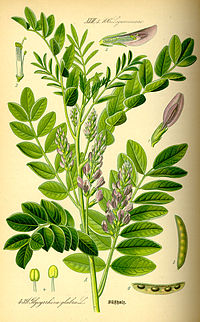
Radiocarbon age discrepancies between the carbonate cement and the root relics of rhizoliths from the Badain Jaran and the Tengeri deserts, Northwest China
Sign Up to like & getrecommendations! Published in 2019 at "CATENA"
DOI: 10.1016/j.catena.2019.04.011
Abstract: Abstract Carbonate rhizolith is one of mineral encrustations of plant roots. The radiocarbon (14C) dates and stable carbon isotopes of rhizoliths are widely used to study geochronology, paleoclimate, paleoecology and paleoenvironment changes. However, due to… read more here.
Keywords: soil; plant; root relics; carbon ... See more keywords

Erosion-reducing effects of plant roots during concentrated flow under contrasting textured soils
Sign Up to like & getrecommendations! Published in 2021 at "Catena"
DOI: 10.1016/j.catena.2021.105378
Abstract: Abstract The effects of plant roots on water erosion are likely to vary according to the range of root traits and soil textures. However, little is known about the erosion-reducing potential of roots under different… read more here.
Keywords: effects plant; erosion reducing; soil; erosion ... See more keywords

How do root and soil characteristics affect the erosion-reducing potential of plant species?
Sign Up to like & getrecommendations! Published in 2017 at "Ecological Engineering"
DOI: 10.1016/j.ecoleng.2017.08.001
Abstract: Plant roots can be very effective in stabilizing the soil against concentrated flow erosion. So far, most research on the erosion-reducing potential of plant roots was conducted on loamy soils. However susceptible to incisive erosion… read more here.
Keywords: plant roots; erosion; erosion reducing; soil ... See more keywords

Responses of soil phosphorus fractions after nitrogen addition in a subtropical forest ecosystem: Insights from decreased Fe and Al oxides and increased plant roots
Sign Up to like & getrecommendations! Published in 2019 at "Geoderma"
DOI: 10.1016/j.geoderma.2018.09.028
Abstract: Abstract Elevated nitrogen (N) deposition may exacerbate soil phosphorus (P) limitations in P-deficient subtropical forest ecosystems. However, which abiotic factors predominantly contribute to soil P transformations and how plant roots affect soil P variations after… read more here.
Keywords: soil; soil phosphorus; subtropical forest; addition ... See more keywords

Listeria monocytogenes - Danger for health safety vegetable production.
Sign Up to like & getrecommendations! Published in 2018 at "Microbial pathogenesis"
DOI: 10.1016/j.micpath.2018.04.034
Abstract: The microbiologically contaminated vegetables represent a risk for consumers, especially vegetables without thermal processing. It is known that human pathogen bacteria, such as Listeria monocytogenes, could exist on fresh vegetables. The fresh vegetables could become… read more here.
Keywords: listeria; plant roots; root; listeria spp ... See more keywords

Nitrogen-Regulated Theanine and Flavonoid Biosynthesis in Tea Plant Roots: Protein-Level Regulation Revealed by Multiomics Analyses.
Sign Up to like & getrecommendations! Published in 2021 at "Journal of agricultural and food chemistry"
DOI: 10.1021/acs.jafc.1c02589
Abstract: Theanine and flavonoids (especially proanthocyanidins) are the most important and abundant secondary metabolites synthesized in the roots of tea plants. Nitrogen promotes theanine and represses flavonoid biosynthesis in tea plant roots, but the underlying mechanism… read more here.
Keywords: plant roots; tea plant; tea; flavonoid biosynthesis ... See more keywords

Inhibitory effect of TiO2 NPs on symbiotic arbuscular mycorrhizal fungi in plant roots.
Sign Up to like & getrecommendations! Published in 2017 at "IET nanobiotechnology"
DOI: 10.1049/iet-nbt.2016.0032
Abstract: While nanoparticles (NPs) are known to exhibit antimicrobial properties, their effects on symbiotic arbuscular mycorrhizal fungi (AMF) in plant roots has to be carefully examined as NPs particularly of titanium dioxide (TiO2) reach plant roots… read more here.
Keywords: tio2; plant; plant roots; tio2 nps ... See more keywords

Bacteria from wheat and cucurbit plant roots metabolize PAHs and aromatic root exudates: Implications for rhizodegradation
Sign Up to like & getrecommendations! Published in 2017 at "International Journal of Phytoremediation"
DOI: 10.1080/15226514.2017.1303805
Abstract: ABSTRACT The chemical interaction between plants and bacteria in the root zone can lead to soil decontamination. Bacteria that degrade polycyclic aromatic hydrocarbons (PAHs) have been isolated from the rhizospheres of plant species with varied… read more here.
Keywords: plant; aromatic root; plant roots; bacteria wheat ... See more keywords

Restriction of plant roots in boreal forest organic soils affects the microbial community but does not change the dominance from ectomycorrhizal to saprotrophic fungi.
Sign Up to like & getrecommendations! Published in 2019 at "FEMS microbiology ecology"
DOI: 10.1093/femsec/fiz133
Abstract: Boreal forest soils store significant amounts of carbon and are cohabited by saprotrophic and ectomycorrhizal fungi (ECM). The 'Gadgil effect' implies antagonistic interactions between saprotrophic fungi and ECM. Plant photosynthates support the competitive fitness of… read more here.
Keywords: plant; plant roots; microbial community; community ... See more keywords

Suberized transport barriers in plant roots: the effect of silicon.
Sign Up to like & getrecommendations! Published in 2020 at "Journal of experimental botany"
DOI: 10.1093/jxb/eraa203
Abstract: Plant roots are the major organs that take up water and dissolved nutrients. It has been widely shown that apoplastic barriers such as Casparian bands and the suberin lamellae in the endo- and exodermis of… read more here.
Keywords: roots effect; plant; plant roots; transport ... See more keywords

INHIBITORY EFFECT OF CALCIUM ON CAESIUM ABSORPTION IN PLANT ROOTS.
Sign Up to like & getrecommendations! Published in 2022 at "Radiation protection dosimetry"
DOI: 10.1093/rpd/ncac071
Abstract: Radiocaesium is released into the environment by accidents in nuclear facilities. One of the major issues related with this is the assessment and reduction of internal exposure of crops grown in contaminated soil. To solve… read more here.
Keywords: calcium; inhibitory effect; absorption plant; absorption ... See more keywords